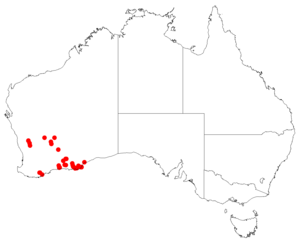Leucopogon breviflorus
| Leucopogon breviflorus | |
|---|---|
| Scientific classification | |
| Kingdom: | Plantae |
| Clade: | Tracheophytes |
| Clade: | Angiosperms |
| Clade: | Eudicots |
| Clade: | Asterids |
| Order: | Ericales |
| Family: | Ericaceae |
| Genus: | Leucopogon |
| Species: | L. breviflorus
|
| Binomial name | |
| Leucopogon breviflorus | |

| |
| Occurrence data from AVH | |
| Synonyms[1] | |
|
Styphelia breviflora (F.Muell.) F.Muell. | |
Leucopogon breviflorus is a species of flowering plant in the heath family Ericaceae and is endemic to the south-west of Western Australia. It is an erect, spindly, glabrous shrub that typically grows to a height of up to about 1.5 m (4 ft 11 in). It has oblong to lance-shaped or linear leaves 4–9 mm (0.16–0.35 in) long on a short petiole and with a small, rigid point on the tip. The flowers are borne singly or in pairs in leaf axils on a short peduncle with small bracts and bracteoles about half as long as the sepals. The sepals are about 2 mm (0.079 in) long and the petals white and about 4 mm (0.16 in) long, the petal lobes longer than the petal tube.[2][3]
It was first formally described in 1864 by Ferdinand von Mueller in Fragmenta Phytographiae Australiae from specimens collected by George Maxwell near Israelite Bay.[4][5] The specific epithet (breviflorus) means "short-flowered".[6]
This leucopogon occurs in the Esperance Plains and Mallee bioregions of south-western Western Australia and is listed (as Styphelia breviflora) as "not threatened" by the Western Australian Government Department of Biodiversity, Conservation and Attractions.[3]
References
- ^ a b "Leucopogon breviflorus". Australian Plant Census. Retrieved 5 July 2022.
- ^ Bentham, George; von Mueller, Ferdinand (1868). Flora Australiensis. Vol. 4. London: Lovell Reeve & Co. p. 222. Retrieved 5 July 2022.
- ^ a b "Styphelia breviflora". FloraBase. Western Australian Government Department of Biodiversity, Conservation and Attractions.
- ^ "Leucopogon breviflorus". APNI. Retrieved 5 July 2022.
- ^ von Mueller, Ferdinand (1864). Fragmenta Phytographiae Australiae. Melbourne: Victorian Government Printer. p. 102. Retrieved 5 July 2022.
- ^ Sharr, Francis Aubi; George, Alex (2019). Western Australian Plant Names and Their Meanings (3rd ed.). Kardinya, WA: Four Gables Press. p. 150. ISBN 9780958034180.
Error: "Q17240901" is not a valid Wikidata entity ID.
- FloraBase ID not in Wikidata
- Articles with short description
- Use Australian English from July 2022
- All Wikipedia articles written in Australian English
- Use dmy dates from July 2022
- Articles with 'species' microformats
- Taxonbars desynced from Wikidata
- Taxonbar pages requiring a Wikidata item
- Taxonbars with invalid from parameters
- Taxonbars without secondary Wikidata taxon IDs
- Leucopogon
- Ericales of Australia
- Flora of Western Australia
- Plants described in 1864
- Taxa named by Ferdinand von Mueller
- All stub articles
- Ericaceae stubs
- Australian asterid stubs